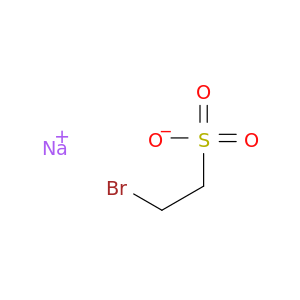
2-Bromoethanesulfonic acid sodium salt
| Title | Journal |
|---|---|
| Polyphasic characterization of two microbial consortia with wide dechlorination spectra for chlorophenols. | Journal of bioscience and bioengineering 20121101 |
| Combination effects of nitrocompounds, pyromellitic diimide, and 2-bromoethanesulfonate on in vitro ruminal methane production and fermentation of a grain-rich feed. | Journal of agricultural and food chemistry 20120111 |
| Methanogens: principal methylators of mercury in lake periphyton. | Environmental science & technology 20110915 |
| Strategies to suppress hydrogen-consuming microorganisms affect macro and micro scale structure and microbiology of granular sludge. | Biotechnology and bioengineering 20110801 |
| Observation of organometallic and radical intermediates formed during the reaction of methyl-coenzyme M reductase with bromoethanesulfonate. | Biochemistry 20100817 |
| Mechanism of inhibition of aliphatic epoxide carboxylation by the coenzyme M analog 2-bromoethanesulfonate. | The Journal of biological chemistry 20100813 |
| Characterization of an enrichment culture debrominating tetrabromobisphenol A and optimization of its activity under anaerobic conditions. | Journal of applied microbiology 20100801 |
| Typical methanogenic inhibitors can considerably alter bacterial populations and affect the interaction between fatty acid degraders and homoacetogens. | Applied microbiology and biotechnology 20100801 |
| Investigation of the effect of culture type on biological hydrogen production from sugar industry wastes. | Waste management (New York, N.Y.) 20100501 |
| Effect of classic methanogenic inhibitors on the quantity and diversity of archaeal community and the reductive homoacetogenic activity during the process of anaerobic sludge digestion. | Bioresource technology 20100401 |
| Effect of various pretreatment methods on anaerobic mixed microflora to enhance biohydrogen production utilizing dairy wastewater as substrate. | Bioresource technology 20080101 |
| Investigation of the diversity of homoacetogenic bacteria in mesophilic and thermophilic anaerobic sludges using the formyltetrahydrofolate synthetase gene. | Water science and technology : a journal of the International Association on Water Pollution Research 20080101 |
| Spectroscopic and kinetic studies of the reaction of bromopropanesulfonate with methyl-coenzyme M reductase. | The Journal of biological chemistry 20061110 |
| The reductive dechlorination of 2,3,4,5-tetrachlorobiphenyl in three different sediment cultures: evidence for the involvement of phylogenetically similar Dehalococcoides-like bacterial populations. | FEMS microbiology ecology 20060201 |
| Evaluation of procedures to acclimate a microbial fuel cell for electricity production. | Applied microbiology and biotechnology 20050701 |
| Anaerobic biodegradability of Tween surfactants used as a carbon source for the microbial reductive dechlorination of hexachlorobenzene. | Water science and technology : a journal of the International Association on Water Pollution Research 20050101 |
| Reductive decolourisation of azo dyes by mesophilic and thermophilic methanogenic consortia. | Water science and technology : a journal of the International Association on Water Pollution Research 20050101 |
| Acetoclastic and hydrogenotrophic methane production and methanogenic populations in an acidic West-Siberian peat bog. | Environmental microbiology 20041101 |
| Probing the reactivity of Ni in the active site of methyl-coenzyme M reductase with substrate analogues. | Journal of biological inorganic chemistry : JBIC : a publication of the Society of Biological Inorganic Chemistry 20040901 |
| Quinone-respiration improves dechlorination of carbon tetrachloride by anaerobic sludge. | Applied microbiology and biotechnology 20040601 |
| Effect of carbon monoxide, hydrogen and sulfate on thermophilic (55 degrees C) hydrogenogenic carbon monoxide conversion in two anaerobic bioreactor sludges. | Applied microbiology and biotechnology 20040401 |
| Effects of several inhibitors on pure cultures of ruminal methanogens. | Journal of applied microbiology 20040101 |
| Anaerobic biodegradation of DDT residues (DDT, DDD, and DDE) in estuarine sediment. | Journal of environmental science and health. Part. B, Pesticides, food contaminants, and agricultural wastes 20010501 |
| Effect of antibiotics, 2-bromoethanesulfonic acid and pyromellitic diimide on methanogenesis in rumen ciliate cultures in vitro. | Archiv fur Tierernahrung 20010101 |